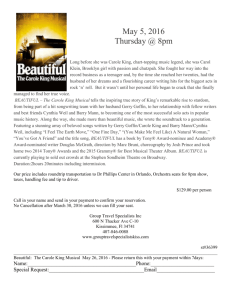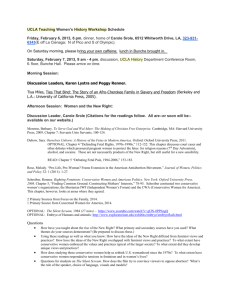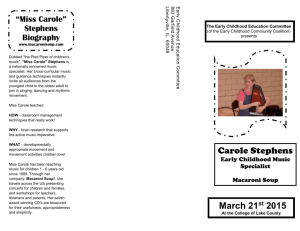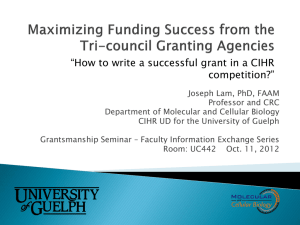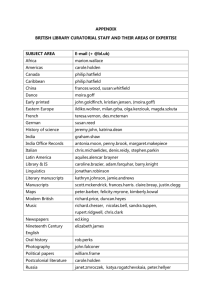Notes by David Last - Canadian Knowledge Transfer and Exchange
advertisement
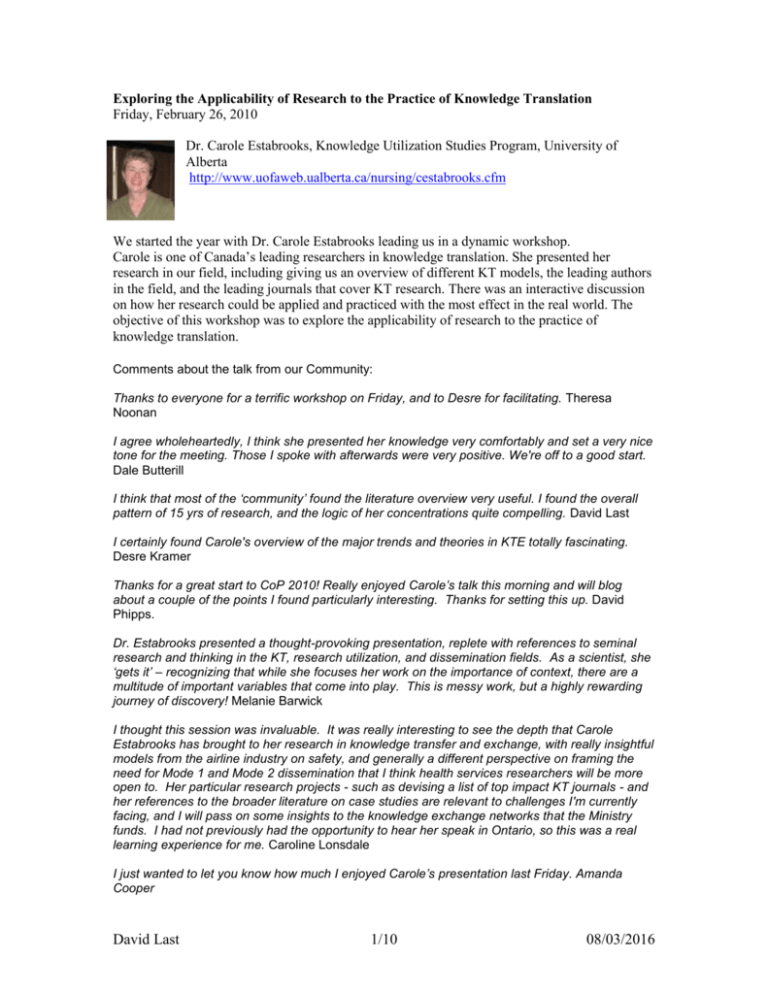
Exploring the Applicability of Research to the Practice of Knowledge Translation Friday, February 26, 2010 Dr. Carole Estabrooks, Knowledge Utilization Studies Program, University of Alberta http://www.uofaweb.ualberta.ca/nursing/cestabrooks.cfm We started the year with Dr. Carole Estabrooks leading us in a dynamic workshop. Carole is one of Canada’s leading researchers in knowledge translation. She presented her research in our field, including giving us an overview of different KT models, the leading authors in the field, and the leading journals that cover KT research. There was an interactive discussion on how her research could be applied and practiced with the most effect in the real world. The objective of this workshop was to explore the applicability of research to the practice of knowledge translation. Comments about the talk from our Community: Thanks to everyone for a terrific workshop on Friday, and to Desre for facilitating. Theresa Noonan I agree wholeheartedly, I think she presented her knowledge very comfortably and set a very nice tone for the meeting. Those I spoke with afterwards were very positive. We're off to a good start. Dale Butterill I think that most of the ‘community’ found the literature overview very useful. I found the overall pattern of 15 yrs of research, and the logic of her concentrations quite compelling. David Last I certainly found Carole's overview of the major trends and theories in KTE totally fascinating. Desre Kramer Thanks for a great start to CoP 2010! Really enjoyed Carole’s talk this morning and will blog about a couple of the points I found particularly interesting. Thanks for setting this up. David Phipps. Dr. Estabrooks presented a thought-provoking presentation, replete with references to seminal research and thinking in the KT, research utilization, and dissemination fields. As a scientist, she ‘gets it’ – recognizing that while she focuses her work on the importance of context, there are a multitude of important variables that come into play. This is messy work, but a highly rewarding journey of discovery! Melanie Barwick I thought this session was invaluable. It was really interesting to see the depth that Carole Estabrooks has brought to her research in knowledge transfer and exchange, with really insightful models from the airline industry on safety, and generally a different perspective on framing the need for Mode 1 and Mode 2 dissemination that I think health services researchers will be more open to. Her particular research projects - such as devising a list of top impact KT journals - and her references to the broader literature on case studies are relevant to challenges I'm currently facing, and I will pass on some insights to the knowledge exchange networks that the Ministry funds. I had not previously had the opportunity to hear her speak in Ontario, so this was a real learning experience for me. Caroline Lonsdale I just wanted to let you know how much I enjoyed Carole’s presentation last Friday. Amanda Cooper David Last 1/10 08/03/2016 Dr. David Last, Royal Military College, took the following notes at the workshop. Thanks David! Overview: 1. Models of Knowledge Transfer 2. What is Knowledge Transfer Research? 3. Focus on Carole’s research agenda 1. Models of Knowledge Transfer A lot has changed in the last ten years; there has been an explosion of KTE as a field. We come from many disciplines, many which are interrelated. 1.1. Diffusion of Innovation theory (Everett Rogers). Elements: the innovation, communication channels, time, social system. Attributes: the innovation, the individual, the organization. The diffusion curve – early adopters, late adopters, opinion leader research Carole commented that we now seem to know much about the attributes of the individuals and the context, but we do not know enough about the attributes of innovations that result in research uptake. This would be worth knowing since it is often easier to manipulate the innovation than to change behaviour. 1.2. Implementation science. Reference: 2007 article by Madon, Hofman, Kupfer and Glass. That can be found at:http://www.sciencemag.org/cgi/content/short/318/5857/1728 “Unlike routine applied or operations research, which may identity and address barriers related to performance of specific projects, implementation science creates generalizable knowledge that can be applied across settings and contexts to answer central questions.” An example would be that 30-40% of patients do not receive care based on current best practice (and other shocking stats that are good for grant proposals) There is a theory-practice gap: Practice fails to live up to theory; a relationship problem exists between clinicians and organizations; theory is often regarded as irrelevant to practice (Allmark, 1995). Theories are ideas about what might work. They give us ideas for interventions, but they are just theories and should be and can be manipulated to be relevant to the context; Carole feels the same way about methods. An example of how to use theory to explain practice can be the R. Amalberti, systemic migration to boundaries model that looks at performance adherence to best practices of a typical clinical group: David Last 2/10 08/03/2016 The Nature of Human Beings: LOW VERY UNSAFE SPACE Individual Benefits HIGH Systemic Migration of Boundaries 100% Agreement Nonacceptable Ō Illegal normalÕ Real Life standards BTCU Usual Space Of Action ACCIDENT HIGH 100% 60 -95% Expected safe space of action as defined by professional Safety RegÕ s & standards good practices Certification accreditation standards Production Performance LOW Rene Amalberti, MD, PhD Left to right Very unsafe space Worry space Illegal normal but which reflects real life standards Safety regulations and good practices, certifications/accreditation standards The usual space of action in a clinical setting is between the illegal normal and safety regs; the focus should be on the normal space, rather than “gold standard” for safety regs. New practices when they are first implemented and major incidents tend to be in the far left – they are in the worry space for a long time before accidents happen Central problems in the management of the adoption of innovations 1. human –managing attention; she thinks this is the key. You are always competing for attention all the time 2. process –managing new ideas into good currency; people believe they should be sustained 3. structural – managing whole-part relations, i.e. ability to keep your eye on the larger picture, and not drop into micro busy-work, where no progress will be made. 4. strategic – institutional leadership, creating a context requires strategic leadership 1.3. Policy analysis frameworks: social, problem/issue, Information (producers, purveyors, knowledge) on the left; values (ideology, belief, interest) on the right The easy way to leverage change is to work on interests, e.g. changing a fee structure for a group, which is easier than changing institutional culture. The best example of is change is the reduction in smoking. This was achieved largely through legislation. Yet the time frame was five decades to change beliefs; research can change attitudes. David Last 3/10 08/03/2016 The average time that it takes to adopt an innovation is 19 years. Many examples show adoption rates of 12-30 years. e.g. It took 20 years to move to antibiotics for peptic ulcers; reason it took so long was that beliefs and ideologies were ingrained. These beliefs can be changed over time, with research, but it works better if you SEE the innovations implemented. ----------Discussion on examples of slow adoption of innovative ideas: David Phipps: yes, this resonates, seatbelts etc. but the adoption of condom use in the gay community was very quick; sometimes social marketing can change behaviour faster than in clinical settings. It is often easier to change the people than to change their beliefs – organizations change as their personnel are renewed. Dale Butterill: We should watch were the ‘cookies’ (rewards, acknowledgement) go, and who gets them. Amanda Cooper: It is not only the length of time that is important, but the resources and the scale of change you are looking for. Carole Estabrooks: don’t ascribe to conspiracy what can be explained by disorganization. If everyone is doing the same thing, it doesn’t matter if it is wrong – you have to see the change working before you believe. For example, a lot of change management trips up on deep-seated ideologies; e.g. Royal Commission under Baird and McTeer on reproductive technology; this was the first time a PM fired half of the commissioners becaue they could not communicate with each other. There was a feminist group and a science group, and McTeer and the Quebec feminists had to go – there is nothing to be gained in ideological battles; you have to pay attention to beliefs, ideologies and interests. David Last 4/10 08/03/2016 Amanda: qv business literature, it is NOT a know-do gap, but a do-know gap. It is only by doing something and seeing it work that you can you change beliefs, so maybe there should be mandatory behaviour change? Other thoughts: The problem is that with low-incidence (like seatbelts) people don’t see any difference. There has to be enforcement of the mandate. We know helmets work, seatbelts work, etc, but how do we get to that point of adoption? It is hard to get from the penetration with early adopters to a system change (‘tipping point’). Maybe the more complicated the behaviour, the longer it takes to get to the tipping point: e.g. kids’ helmets, booster seats, padding etc. 1.3. CIHR Model: CIHR defines knowledge translation as “Knowledge translation is the exchange, synthesis and ethically-sound application of knowledge - within a complex system of interactions among researchers and users - to accelerate the capture of the benefits of research for Canadians through improved health, more effective services and products, and a strengthened health care system…” http://www.cihr-irsc.gc.ca/e/26574.html#defining CIHR knowledge to action cycle (Graham et al, 2006) [see photo] David Last 5/10 08/03/2016 1. The outer cycle: monitor knowledge use, evaluate outcomes, sustain knowledge use, identity problem/identify review select knowledge, adapt knowledge to local context, assess barriers to knowledge use, select, tailor, implement interventions (all two-way arrows) 2. The inner clockwise circle with inverted triangle: knowledge inquiry, synthesis, products/tools (tailoring knowledge on the hypotenuse) Comment: We are particularly bad at evaluating outcomes, 1.4 Normalization process theory (May et al, Implementation Science, 2009 4:29 -normalization process theory explains how new technologies, ways of acting, and ways of working become routinely embedded in everyday practice, and has applications in the study of implementation processes. 1.5 PARiHS Framework for Research Implementation (Kitson et al 1998; 2008; Rycroft-Malone et al, 2002) Esterbrooks uses this framework a lot, If you have good evidence in a favourable context, you can facilitate change The model is criticized for not addressing the role of the individual user We know that leadership, culture, evaluation are not all there is to Context, but this is a good start Kitson et al. have published a context analysis for each of these factors David Last 6/10 08/03/2016 2. What is knowledge translation research? It is research into the determinants and mechanisms of the dissemination and uptake of research knowledge in the context of decision making at clinical, organization, and regional and higher levels of the health system The goal is improvements in health outcomes, care delivery, and or system performance It is like “used knowledge sales” (!) Not everyone has the same goal in changing outcomes, although that is the norm in health field. CIHR is focused on knowledge translation because of political interest. 2.1 Barriers to research utilization (Nilsson-Kajermo, Bostromm, et al, Implementation science (calls for no further research on the barrier to knowledge utilizatioon!) -studied extensively, possibly excessively in nursing -findings are consistent but have told us little since early studies -not used to inform interventions -however, barriers do need to be assessed to determine viable interventions; -the barrier scale has high reliability but questionable validity, so Nursing has suffered – it always tells you that TIME is a barrier, but this doesn't help much. There is a lot behind it. 2.2 Commonly identified barriers to research use: -time -resources -support -knowledge and skills -adequate evidence -need more research on culture, context, environment e.g. “busy-ness” is very complex concept that includes issues such as access to computers, and using internet as knowledge source. David Last 7/10 08/03/2016 3. Carole Estabrooks’ Research Divided the work into three phases, 1997-2012 Talked mostly about 5-6-7 The seventh phase will be the bane of her life: “CIHR likes big complex studies, but we don’t have the tools to do these properly yet”. 3.1 A bibliometric analysis of the knowledge utilization literatures’ structure and substance Refs: (Estabrooks, Lavis, Wallin, Scott, Profetto-McGrath) We analyzed the Web of Science over 60 years (1945-2004), descriptive findings, first author cocitation analysis. We had to learn how to do a bibliometric analysis, it was a high cost study and she wouldn’t recommend it It does help to understand the structure of the field [her scatterplots with relative significance of key authors and division of the field is a real contribution to mapping a discipline; though she wouldn’t recommend repeating it – presumably, although it makes a nice visual, and would be a good teaching and research tool, it was more trouble to complete than it was worth? Can librarians do this with automated tools?] David Last 8/10 08/03/2016 3.2 Key journals publishing KT research: You can go to Web of Science and get ratings by category jnl of eval in clinical practice jnl of adv nsg bmj knowledge: creation diffusion, utilization [became Science Communication] Lancet Jnl of general internal mediice Research policy JAMA Science communication Social science and medicine [The following sections will be easier to follow from Carole’s slides; she went a bit too fast to take notes] Findings. There is a first author co-citation map and the bigger the bubble, the more co-citations and influence. Three groups of authors and concentrations have emerged: knowledge utilization, diffusion of innovation, technology transfer; Noted that from 1985-1994 a new group emerged: evidence-based medicine; Everett Rogers remains big across the decades, but the big linker is Jonathan Lomas; he is now a boundary spanner in bringing fields together. From 1995-2004, you find that an emerging field is tech transfer. Diffusion of innovation, and knowledge utilization are still there, but now evidence based medicine is an exploding field. 3.3 Research into the determinants of research utilization pain management in adults and children (1999-2003). Study was funded by NHRDP /CIHR, AHFMR. -four hospitals, (two in Ontario, two in Alberta) -adult and paediatric surgical units -qualitative and quantitative data collected six months of participant observation each unit focus was on nurses 3.4 Research led to a taxonomy of nurses’ sources of knowledge: (Estabrooks, Rutakumwa, O’Leary, Profetto-McGrath, Levers, et al, 2005 “Sources of Practice Knowledge among Nurses” Qualitative Health Research.) Research question: what influenced ideas about pain management? Findings: social interactions, and experience, -Nurses don’t read much; they can’t get what they need from reading. -they need quick answers to immediate questions, and the databases don’t help; this is a big gap in the field, which doesn’t assess the sort of work that practitioners do. Q: The experience of what worked last time is not a good guide to practice; research is the external validation of experience; you can’t just rely on peers and experience. A: peers can be quite problematic, juniors don’t want to go to seniors, so they don’t get the best advice, they gravitate to the people who are nice to them. David Last 9/10 08/03/2016 Comment: we have talked about social marketing. The client here is the practitioner. We have to ask what are their preferences? It is complex and messy, and there is no good research on the subject. We can’t get funding for this sort of research. Q: CIHR project “moulding young minds” – no one has asked young adults what they want to see and in what form. Q: adverse events really change practice – if something goes horribly wrong it will cast a long shadow. So even if you know that you should be doing some best practice, if something has gone wrong in the past, you will never repeat that behavior. A: cognitive sciences are sometimes hard to work with; single vivid case has a profound impact, and you can’t overcome this. But there are educational interventions… 3.5 Seven healthcare unit comparison. Goal is understanding the influence of context on knowledge translation. Suite of three programs: -pediatric acute care -adult acute care -elder care Findings overall are that there are few differences in the sources used by nurses across units; they are learning from the PRINCIPLES, rather than the actual facts, that they learned 20 years ago. Participant comment: there is a sense that if the ministry or the school board tells us to do something, then it must be evidence based, and they don’t feel obliged to go to the origianal source A: yes, but although nurses trust doctors as a credible source of information, it is falsely-based trust. Interventions include education, in-service, reminders, audit with feedback, knowledge brokers and other intermediaries (she has changed her mind about this – a gap is not always the issue) What’s missing: context of work of nursing services delivery; system, organizational environment; feasibility; modifiability; sustainability References from Carole: Carole is rereading Everett Rogers, and getting a better impression of how useful his models are; To learn more about the process piece: Sue Dobson, Knowledge to Action, synthesis of 40 cases studies from the NHS, 8 processes summarized. []ACT dimensions by site – there are differences by site on scores for key concepts Some lessons learned: Participants wanted something for feedback at interims not just at the very end. This is something to think about for a longitudinal study. David Last 10/10 08/03/2016
